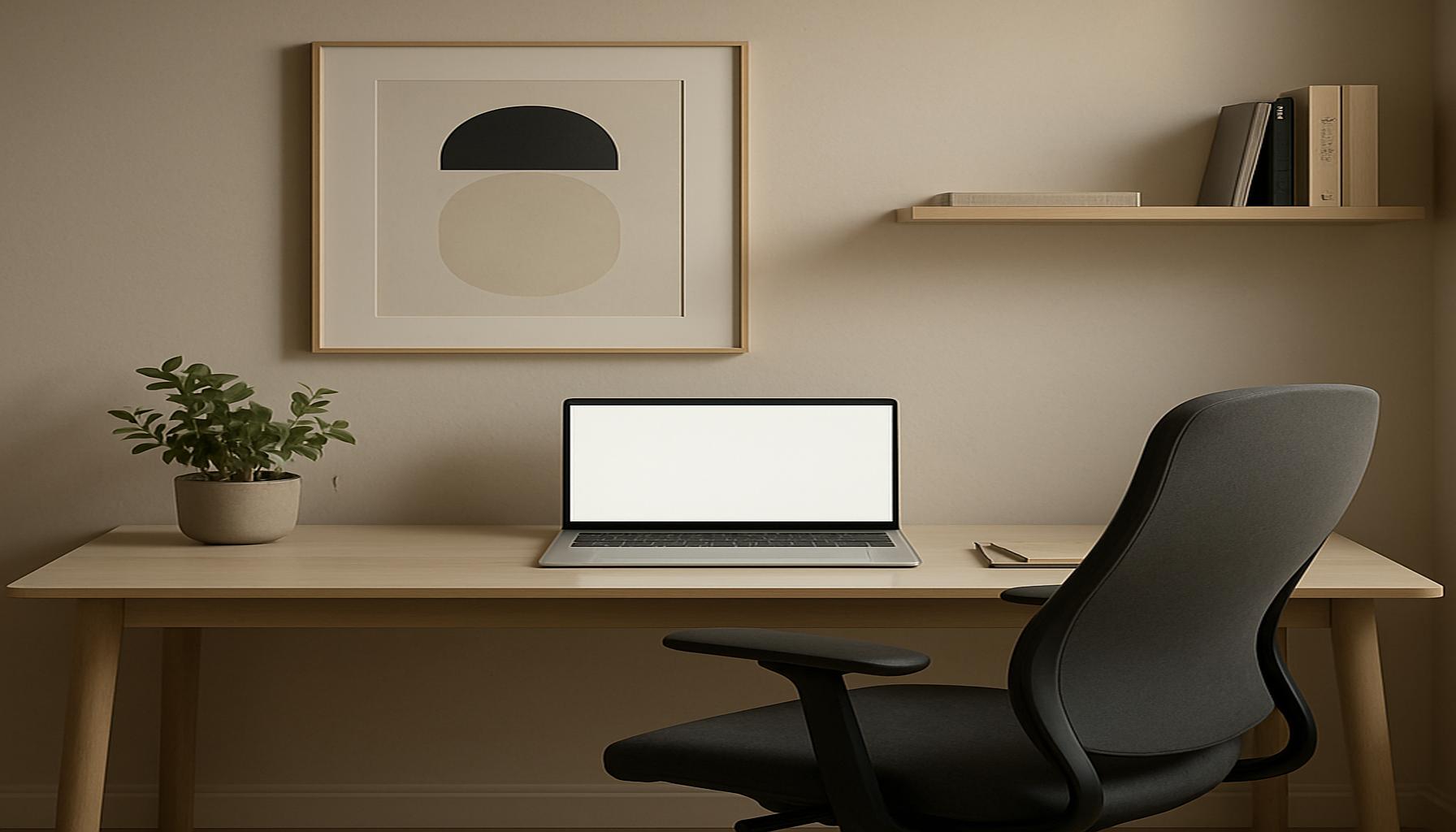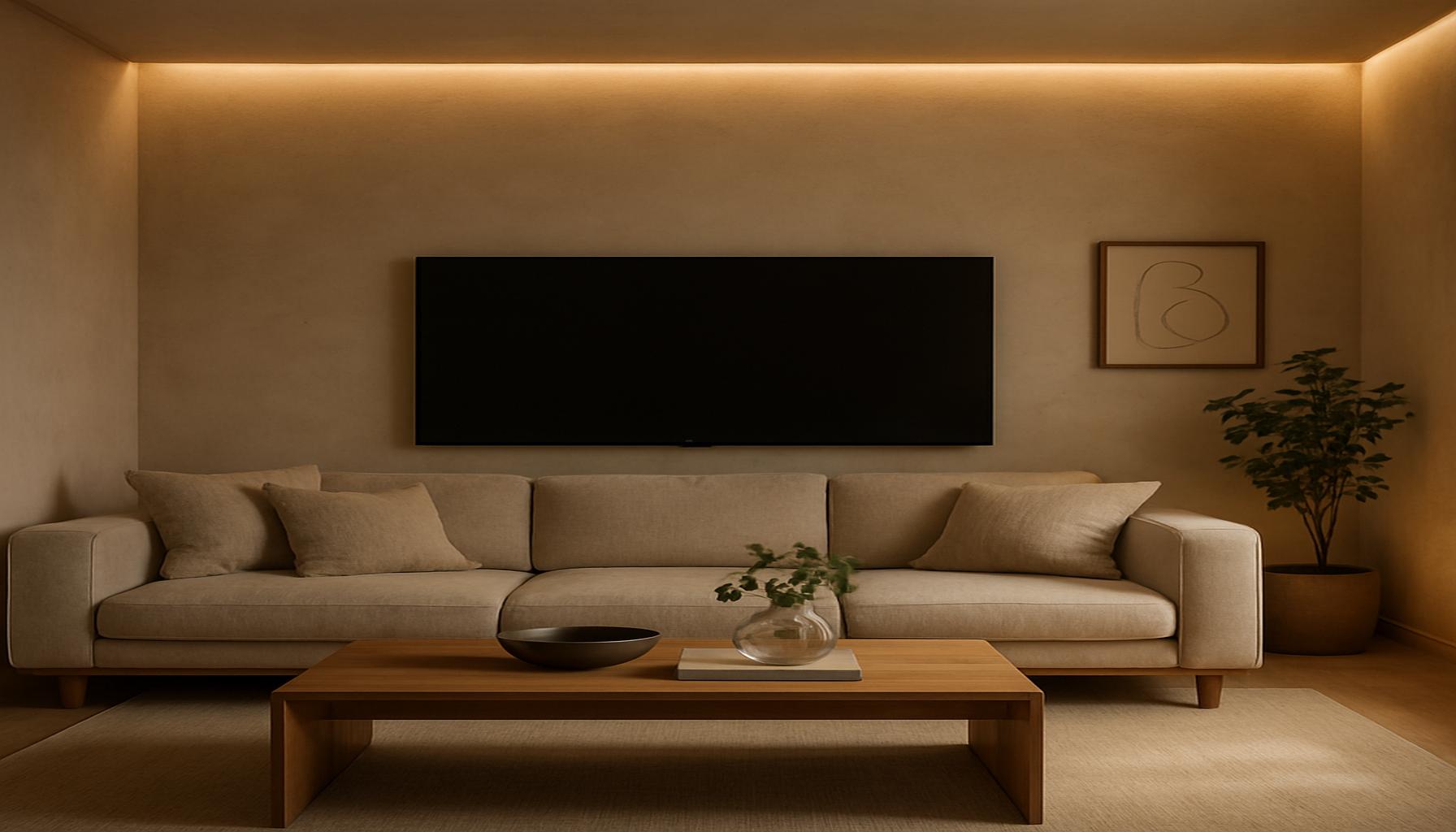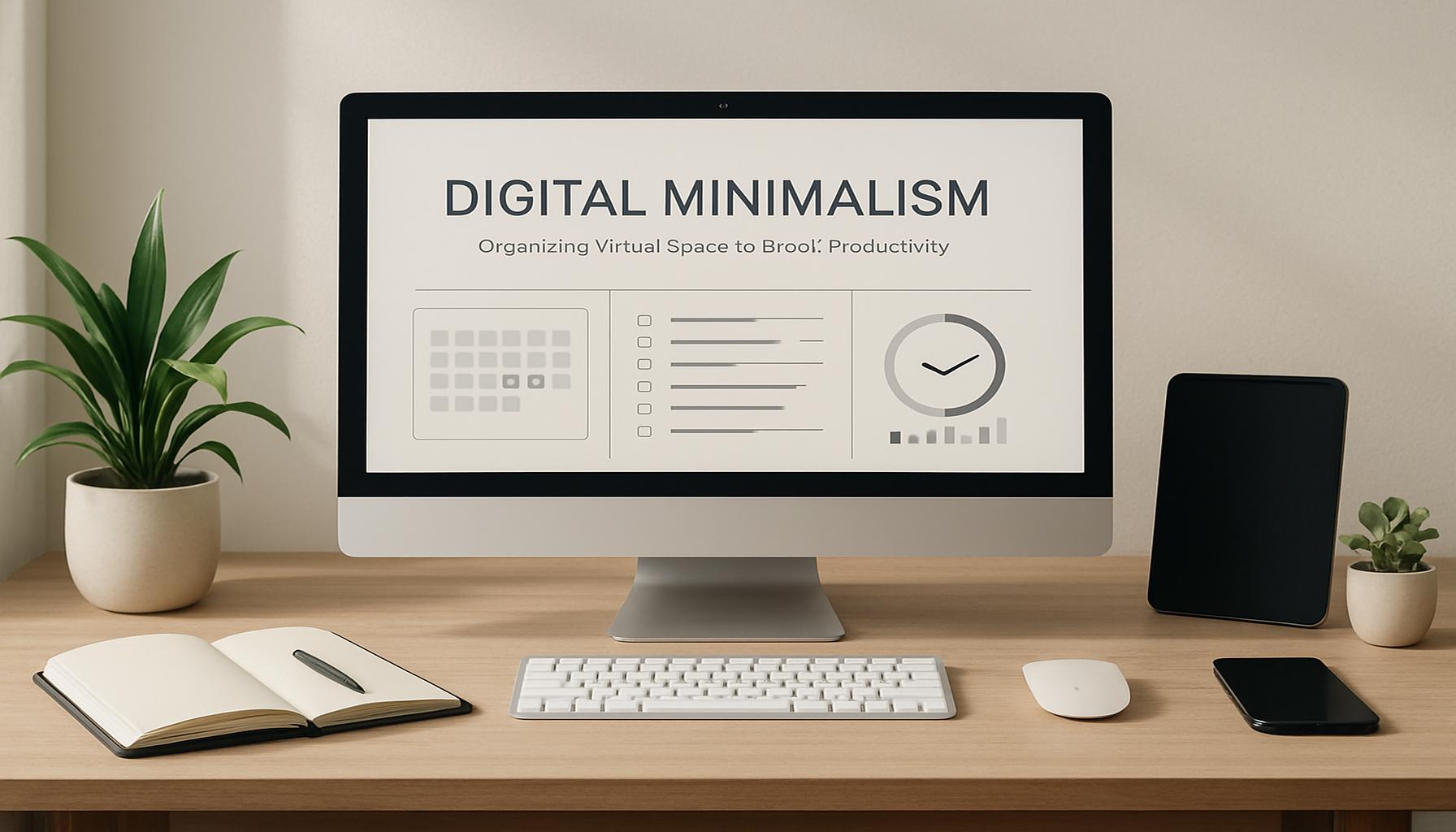Maximize Small Workspaces Minimalism Techniques for Transformation
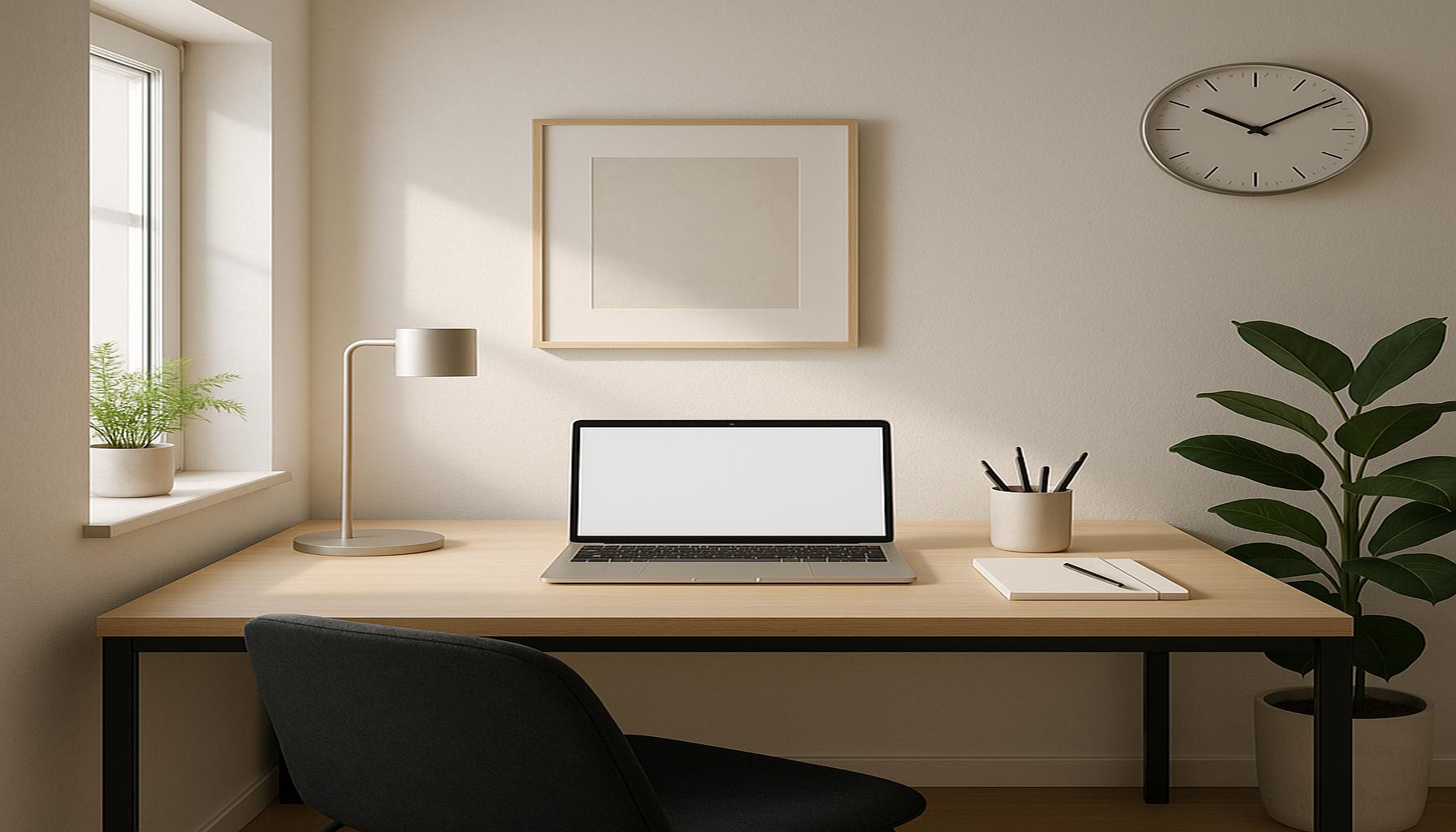
Unlocking Potential in Small Spaces
In today’s world, where many find themselves navigating the blend of personal and professional life from home-based setups or confined office cubicles, the need to optimize every square foot becomes crucial for sustaining productivity. Embracing minimalism transforms this challenge into an opportunity. Minimalism is more than just a design trend; it’s a lifestyle choice that fosters simplicity, efficiency, and organization. This makes it highly beneficial for individuals working in small workspaces.
By adopting minimalist principles, one doesn’t just improve the visual appeal of their environment. It also helps in decluttering the mind, thus paving the way for enhanced focus and creativity. A clean and organized space often leads to a calm and inspired mindset, essential for tackling any professional task efficiently.
Techniques for an Organized Workspace
In this article, we’ll delve into five effective techniques that promise to maximize your small workspace’s potential. These strategies prove that tiny areas can indeed yield substantial results, enabling you to work smarter, not harder:
- Declutter Regularly: Start by removing unnecessary items. Ask yourself if each item truly serves a purpose. This ongoing process ensures only essentials remain.
- Use Multifunctional Furniture: Invest in furniture pieces that offer more than one use. For instance, a desk that doubles as storage helps save space while keeping essentials at hand.
- Vertical Storage Solutions: Utilize wall space with shelves or wall-mounted organizers. This frees up floor space while providing easy access to frequently used items.
- Opt for a Neutral Color Palette: Light colors tend to open up a space, making it appear bigger and more inviting. Consider whites, beiges, and light grays to create an airy atmosphere.
- Incorporate Natural Light: Position your workspace near windows if possible. Natural light not only improves mood but also enhances focus and productivity.
Each of these techniques, when thoughtfully applied, can transform your small workspace into a hub of productivity and creativity. As more people encounter the necessity of working in compact spaces, understanding and applying these strategies becomes imperative. Don’t let a small area constrain your capabilities; instead, let it inspire a more efficient and focused work ethic.
Top 5: Optimizing Small Spaces – How Minimalism Can Transform Your Workspace
In today’s fast-paced world, where remote work and flexible office environments are redefining traditional job roles, the importance of a functional, organized workspace cannot be overstated. Limited space challenges many of us, whether working from a home office or a compact corporate setting. This article explores how embracing minimalism can be a life-changing approach to small workspaces. We delve into **five essential tips** that align minimalist principles with workspace optimization, enhancing productivity, sparking creativity, and promoting overall well-being.
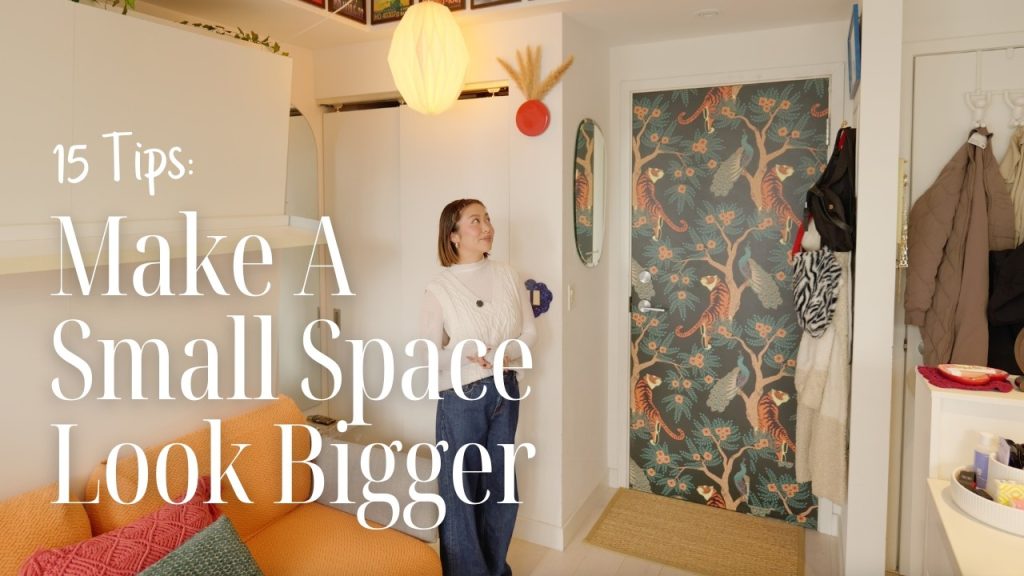
5. Declutter Your Desk
A cluttered desk is often the physical manifestation of a cluttered mind. To foster productivity and peace, begin by **decluttering your desk**. A tidy workspace minimizes distractions and reduces stress, paving the way for more effective work. The process starts with sorting every item on your desk, a task that might initially seem daunting but pays off significantly in the long run.
- Adopt a system for categorizing items: Create distinct piles labeled Keep, Donate, or Trash.
- Limit the items you return to your desk to essentials, such as your computer, a functional lamp, and a minimalistic plant to bring tranquility and life into the space.
- Utilize drawers or storage boxes to house non-essential items that you don’t frequently use.
A clean desk equals a clear mind, leading to enhanced focus and efficiency. In the world of work, sometimes **less truly is more**. This minimalist approach ensures you center attention on tasks that matter most, unburdened by unnecessary distractions.
4. Utilize Vertical Space
Small workspaces often conjure images of cramped corners and limited movement. However, by **utilizing vertical space**, you can transform your workspace into a functional and inviting arena. Vertical organization is a game-changer when floor space feels insufficient, turning bare walls into storage goldmines.
- Install floating shelves to neatly organize books and decorative items, keeping your desk clutter-free.
- Employ a pegboard to systematically arrange tools, cords, and supplies, making them accessible yet unobtrusive.
- Consider wall-mounted desks capable of folding away when not in use, an ideal solution for versatile spaces.
Thinking upwards instead of horizontally helps in crafting a workspace that caters to your needs without feeling overcrowded. This strategy not only maximizes utility but also adds an element of stylish design to your environment.
3. Embrace Multi-Functional Furniture
In compact spaces, every piece of furniture must earn its place. To enhance utility without overcrowding, **embrace multi-functional furniture**. Such furniture pieces often serve dual purposes, providing practicality and style.
- Choose desks that double as storage units, saving space while still offering ample storage for office supplies.
- Incorporate ottomans or benches with hidden storage, combining comfort with practical use.
- Opt for foldable chairs and tables that can be stored away, offering flexibility for your workspace configuration.
Each piece should meet specific demands, helping you maintain a clutter-free zone while leveraging your limited space to the fullest potential. This mindful selection of furniture can significantly transform a workspace, enabling a seamless transition between professional and personal use.
2. Implement a Color Palette
The ambiance of a workspace greatly influences our mood and productivity levels. A well-thought-out **color palette** is instrumental in creating an organized, aesthetically pleasing environment. Minimalism champions a restricted use of colors, promoting harmony and reducing visual chaos.
- Opt for a neutral palette—whites, greys, and beiges create a calm and clean backdrop.
- Add touches of color using accessories like cushions or inspiring artwork, providing vibrancy without overpowering the space.
- Limit your color scheme to ensure the workspace remains cohesive and uncluttered.
The strategic choice of colors can make the environment feel larger, fostering an inviting atmosphere conducive to productivity and creativity. The correct palette can transform a space into more than a workspace—it becomes a personal sanctuary.
1. Prioritize Ergonomics and Comfort
At the forefront of minimalist workspace design lies the imperative of **prioritizing ergonomics and comfort**. A workspace should not only be visually appealing but also physically accommodating, especially in small settings where comfort may be compromised.
- Invest in an ergonomic chair that ensures proper posture, promoting long-term health and reducing fatigue.
- Ensure your desk’s height is suitable to prevent discomfort and strain on your neck and back.
- Incorporate adequate lighting to minimize eye strain, fostering a conducive work environment.
Focusing on comfort and functionality allows for a significant boost in productivity and satisfaction. Minimalism extends beyond mere aesthetics; it embraces the creation of a space that nurtures well-being and efficiency.
In conclusion, embracing minimalism in small office environments offers an opportunity for transformative changes in productivity and satisfaction. By making slight adjustments and adopting these five crucial tips, you can curate a workspace that is not only functional but also tailored to enhance your work-life experience. As minimalism underscores the refinement of space, it invites you to explore what truly contributes to a fulfilling work environment.
When it comes to optimizing small spaces, the essence of minimalism becomes paramount. The notion revolves around decluttering and implementing strategic layouts that enhance functionality while creating an aesthetically pleasing environment. Here’s an in-depth exploration of how minimalism can reshape your workspace and maximize productivity.One of the primary elements of minimalism is the reduction of visual chaos. A cluttered desk can distract even the most focused individual, leading to decreased productivity. By opting for essential furnishings and limiting the number of personal items on display, individuals can create a serene atmosphere that fosters creativity and efficiency. For those who may struggle to stay organized, a carefully curated workspace can serve as both a functional area for work and a calm sanctuary. Additionally, the implementation of multipurpose furniture is critical in a small work environment. Consider investing in a desk that doubles as a filing cabinet or a wall-mounted workstation that can be folded away when not in use. This approach not only saves space but also encourages a more efficient use of the area. Modern design trends emphasize the importance of versatility, allowing individuals to adapt their environment according to their needs at any given moment.Lighting is another crucial aspect of workplace optimization. Minimalist design tends to favor natural light, promoting well-being and productivity. Large windows or strategically placed mirrors can enhance the illumination in a small office, making the space feel larger and more inviting. For those who work late, adjustable light fixtures provide the flexibility to tailor brightness levels to individual preferences. The right lighting can profoundly affect mood, energy, and focus, making it a vital element of any workspace.Moreover, incorporating greenery can dramatically alter the dynamic of a workspace. Plants not only purify the air but also add an organic touch to a minimalist design. They bring life into otherwise sterile environments, and their presence can lead to increased job satisfaction and reduced stress levels. Succulents or small potted plants are wonderful options for ensuring a touch of nature without overwhelming the space.Lastly, the principle of digital minimalism is gaining traction, focusing on reducing smartphone and computer clutter. This involves minimizing the number of tabs open on a browser, organizing files into clearly labeled folders, and turning off non-essential notifications. By creating a streamlined digital workspace, you can maintain focus and reduce the cognitive load that comes with multitasking in a cluttered digital environment.Overall, employing minimalist principles in a small workspace can lead to significant benefits, from improved organization and increased productivity to enhanced well-being and creativity. By thoughtfully selecting furniture, maximizing natural light, incorporating nature, and reducing digital clutter, individuals can effectively transform their working environments into functional, harmonious spaces. The minimalism movement offers a blueprint for cultivating a workplace that not only meets professional needs but also supports mental clarity and personal growth.
Frequently Asked Questions About Optimizing Small Spaces with Minimalism
How can minimalism effectively optimize my small workspace?
Minimalism emphasizes the necessity of reducing clutter and focusing on essential items. By doing so, it creates a more organized environment that doesn’t feel cramped. Utilizing minimalism can lead to a clearer, more functional workspace that improves productivity by minimizing distractions and providing only what is crucial for work.
What are some practical steps to start implementing minimalism in my workspace?
Begin by conducting an audit of your current workspace. Identify items that are not used frequently or don’t serve a purpose; these are candidates for removal. Consider investing in multi-purpose furniture or storage solutions that maximize utility. Maintain only items that add value to your work or inspire creativity, ensuring a more streamlined environment.
Can minimalism really enhance creativity and productivity in a workspace?
Yes, minimalism can significantly enhance both creativity and productivity. By eliminating excess and focusing on essentials, minimalism reduces mental clutter, allowing for improved concentration and creative thought processes. A clean and organized space also minimizes stress, leading to a more enjoyable work experience and fostering innovative ideas.
What role does technology play in creating a minimalist workspace?
Technology plays a crucial role in supporting a minimalist approach. It allows for the digitization of documents, reducing paper clutter, and facilitates remote work capabilities, which may eliminate the need for certain physical office items. Utilizing cloud-based tools and applications can help maintain order and accessibility, integrating seamlessly into a minimalist framework.
Conclusion
As we navigate the increasing demands of modern work environments, the concept of minimalism offers a refreshing perspective on optimizing small workspaces. By focusing on the essential, minimalism not only maximizes limited areas but also fosters an enhanced sense of well-being and productivity. Throughout this article, we explored several key strategies to transform a cramped workplace into an efficient, minimalist haven.
Firstly, embracing decluttering as a fundamental principle helps in identifying and removing non-essential items, creating a cleaner and more serene environment. Secondly, the thoughtful selection and placement of functional furniture enhance the flow and efficiency of the workspace. Additionally, integrating multifunctional tools and technology further contributes to a streamlined work setup.
The incorporation of natural elements, such as light and greenery, plays a crucial role in promoting a sense of calm and focus, which is vital for maintaining motivation and mental clarity. Lastly, fostering a focus-driven mindset encourages individuals to concentrate on meaningful tasks, directly impacting productivity and personal satisfaction.
As organizations and individuals continue to adapt to evolving work styles, the principles of minimalism present an opportunity to reimagine our environments. By emphasizing simplicity and purpose, minimalism not only transforms physical spaces but also enriches mental spaces, offering a blueprint for a more meaningful and organized work life. Exploring this path further can yield insights into personal efficiency and satisfaction, making minimalism a significant contributor to modern workplace transformation.
